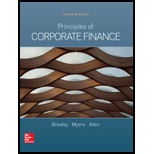
Concept explainers
Bank loans, commercial paper, and medium-term notes* Complete the passage below by selecting the most appropriate terms from the following list:
floating lien, revolving credit, medium-term note, warehouse receipt, unsecured, commitment fee, commercial paper.
Companies with fluctuating needs for cash often arrange a _________ with their bank that allows them to borrow up to a specified amount. In addition to paying interest on any borrowings, the company must pay a _________ on any unused amount.
Secured short-term loans are sometimes covered by a _________, which gives it a general claim on the firm’s assets. Generally, however, the borrower pledges specific assets. For example, a loan may be secured by inventory. In this case, an independent warehouse company provides the bank with a _________, showing that the goods are held on the bank’s behalf and releases those goods only on instructions.
Banks are not the only source of short-term debt. Many large companies issue their own _________ debt directly to investors, often on a regular basis. If the maturity is less than 270 days, the debt does not need to be registered with the SEC and is known as _________. A company may also have a program to sell longer-maturity debt to investors on a continuing basis. This is called a _________ program.
Want to see the full answer?
Check out a sample textbook solution
Chapter 24 Solutions
Principles of Corporate Finance
- Assume an investor deposits $116,000 in a professionally managed account. One year later, the account has grown in value to $136,000 and the investor withdraws $43,000. At the end of the second year, the account value is $107,000. No other additions or withdrawals were made. During the same two years, the risk-free rate remained constant at 3.94 percent and a relevant benchmark earned 9.58 percent the first year and 6.00 percent the second. Calculate geometric average of holding period returns over two years. (You need to calculate IRR of cash flows over two years.) Round the answer to two decimals in percentage form.arrow_forwardPlease help with these questions.arrow_forwardPlease help with 5-6.arrow_forward
- In 1895, the first U.S. Putting Green Championship was held. The winner's prize money was $170. In 2022, the winner's check was $3,950,000. a. What was the percentage increase per year in the winner's check over this period? Note: Do not round intermediate calculations and enter your answer as a percent rounded to 2 decimal places, e.g., 32.16. b. If the winner's prize increases at the same rate, what will it be in 2053? Note: Do not round intermediate calculations and enter your answer as a percent rounded to 2 decimal places, e.g., 32.16. a. Increase per year b. Winners prize in 2053 %arrow_forwardDerek plans to retire on his 65th birthday. However, he plans to work part-time until he turns 73.00. During these years of part-time work, he will neither make deposits to nor take withdrawals from his retirement account. Exactly one year after the day he turns 73.0 when he fully retires, he will begin to make annual withdrawals of $183,008.00 from his retirement account until he turns 94.00. After this final withdrawal, he wants $1.52 million remaining in his account. He he will make contributions to his retirement account from his 26th birthday to his 65th birthday. To reach his goal, what must the contributions be? Assume a 6.00% interest rate. Round to 2 decimal places.arrow_forwardDerek plans to retire on his 65th birthday. However, he plans to work part-time until he turns 71.00. During these years of part-time work, he will neither make deposits to nor take withdrawals from his retirement account. Exactly one year after the day he turns 71.0 when he fully retires, he will begin to make annual withdrawals of $177,333.00 from his retirement account until he turns 94.00. He he will make contributions to his retirement account from his 26th birthday to his 65th birthday. To reach his goal, what must the contributions be? Assume a 9.00% interest rate. Submit Answer format: Currency: Round to: 2 decimal places.arrow_forward
- Derek plans to retire on his 65th birthday. However, he plans to work part-time until he turns 72.00. During these years of part-time work, he will neither make deposits to nor take withdrawals from his retirement account. Exactly one year after the day he turns 72.0 when he fully retires, he will wants to have $3,104,476.00 in his retirement account. He he will make contributions to his retirement account from his 26th birthday to his 65th birthday. To reach his goal, what must the contributions be? Assume a 8.00% interest rate. Submit Answer format: Currency: Round to: 2 decimal places.arrow_forwardBanking and finance sector ma job kaise payearrow_forward1. Bond X is worth $91 today. The bond will mature in one year and pay $100 or $84 with probabilities 0.75 and 0.25, respectively. Assuming the bond pays no cash flows during the year, which of the following is closest to the expected return on the bond? 5% 0% 0% 5% 0% 2. At the beginning of the year, a mutual fund has a NAV of $20. At the end of the year, the NAV is $21 and the fund has received no dividends or other distributions throughout the year. The return on the fund’s benchmark over the same period of time was 10%. Suppose the fund incurred expenses of $2 per fund share during the year. What was the return on the fund’s underlying portfolio before any expenses that affected NAV? Did this before-expense return beat the fund’s benchmark? 15%; Yes, the fund’s underlying portfolio beat its benchmark 15%; No, the fund’s underlying portfolio beat its benchmark 0%; No, the fund’s underlying portfolio beat its benchmark 20%; Yes, the fund’s underlying portfolio beat its benchmark…arrow_forward
 College Accounting, Chapters 1-27AccountingISBN:9781337794756Author:HEINTZ, James A.Publisher:Cengage Learning,
College Accounting, Chapters 1-27AccountingISBN:9781337794756Author:HEINTZ, James A.Publisher:Cengage Learning,

